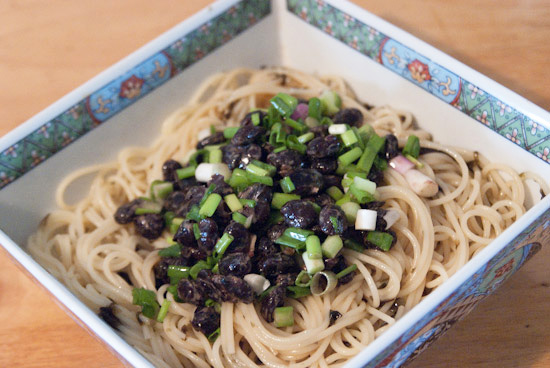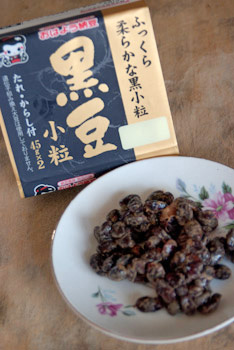
Pasta with natto beans and seaweed
|
|
Natto is a fermented soy product that imparts major health benefits. The beans contain a substance called nattokinase, which is one of the most effective foods in preventing and dissolving blood clots that can cause heart attack, stroke and memory loss.
Unfortunately, natto beans are notorious for being sticky, slimy and smelly. While most Japanese enjoy it, many foreigners find its appearance, smell and taste quite offensive.
One way to get used to the smell and taste of natto - and at the same time remove its stickiness - is to mix it with miso soup. After eating natto this way for a few times, I not only got used to it but actually began to enjoy its acquired taste.
The traditional Japanese way of eating natto beans also helps make it more palatable. This involves serving the fermented soy beans with:
- Shoyu or Japanese soy sauce
- Mustard
- Nori seaweed (in the form of fine strips)
- Spring onion, finely chopped.
This natto mixture is often eaten with rice or soba and other Japanese noodles. This way of serving natto beans was one of the inspirations behind this pasta dish.
Inspirations
A third inspiration for this pasta with natto beans nori seaweed sauce recipe is my own creation, which is pasta served with Chinese-style preserved "olive vegetables". This is a Chinese pickle, sold in bottles or, very rarely these days, home-made by pickle sellers at the markets. All it takes is to add a generous dollop of this "olive vegetable" to ready-cooked pasta, and you get quite a delicious pasta dish. I ever once served it to two American ladies and (unless they were very good actresses) they rather enjoyed it.
The Chinese "olive vegetable" has a similar texture and appearance to nori condiment. And since nori condiment is very easy to prepare, I decided to create my own. It is much cheaper to make at home. I can also make it less salty, as a nori seaweed sauce.
Home made nori seaweed sauce
Nori for wrapping sushi is sold in sheets and good quality nori is costly - at more than US 50 cents per sheet. There are also cheaper types, but avoid those that contain sugar, MSG and other additives.
The much cheaper - and still healthy - version is Chinese-style nori, sold as round, flat "cakes" of the dried nori seaweed. In Singapore, this costs only slightly more than US$1 for a 50 gram pack. This is the seaweed that some Chinese food hawkers add to, for example, fishball noodles or fish porridge. Obviously, the Chinese, too, know about seaweed benefits.
It's easy to make a nori condiment
Ingredients:
- 50 grams nori seaweed
- 2 cups water
- 1/2 cup shoyu
- wasabi powdwer (optional)
Method:
- Add water to the nori and break up the pieces. Make sure the nori is well brokwn-up so that it does not clump together and will mix easily with the pasta later.
- Add shoyu and cook over low heat for 30 minutes or longer, until it forms a thick paste.
- If you wish, add generous dashes of wasabi powder. Note: Get the genuine powdered wasabi root if you can. This is more white, with just a hint of green color. The green powder that is widely sold in Japanese supermarkets as "wasabi" is actually a fake product with artificial coloring and flavoring. Genuine wasabi tastes better and is not as pungent, but is also more costly. If you dont't mind the expense, use grated fresh wasabi root, which costs many dollars for just a short, few-inch section.
Having made the nori condiment, the rest of this recipe for pasta with natto beans and nori seaweed sauce is easy (not that the nori condiment was difficult in the first place):
Pasta with natto beans and nori seaweed
 \
\
Ingredients:
- 4 boxes natto beans
 Natto is normally sold in small styrofoam boxes, each containing about 40 to 50 grams and usually with two to four boxes bundled together. Each box, for one serving, includes a small packet of shoyu and a packet of mustard - but I prefer my own mustard.
Natto is normally sold in small styrofoam boxes, each containing about 40 to 50 grams and usually with two to four boxes bundled together. Each box, for one serving, includes a small packet of shoyu and a packet of mustard - but I prefer my own mustard.
Natto beans are normally light brown. The version pictured here is a special natto made from black soybeans, hence the dark color. I tried this natto for the first time and find that it has a strong - meaning more robust, not smellier - taste and is less sticky than other natto that I had tried.
- 4 stalks of spring onion, chopped
- 1 tbsp yellow mustard
- 300 grams dried pasta, cooked according to instructions
- one amount nori condiment / nori seaweed sauce
- 1 tbsp toasted sesame oil
Method:
- In a large bowl, mix together the natto, spring onions and mustard.
- Separately, toss cooked pasta with the nori seaweed sauce.
- Serve topped with the natto beans mixture.
This is a very "un-Italian" pasta. In fact, it can pass off as a Japanese dish if it is served with soba noodles, except that the Japanese normally eat their natto with nori strips rather than a nori sauce. However, I rather enjoy the crunch of al dente pasta as opposed to softer soba noodles.
|
|
|
|||||||||||||||||||||||||||||||||||||||||||
New! Comments
Have your say about what you just read! Kindly leave a comment in the box below.